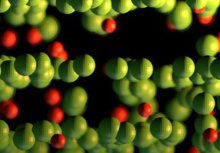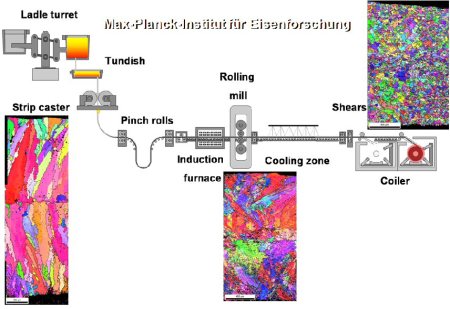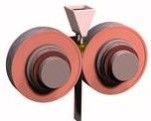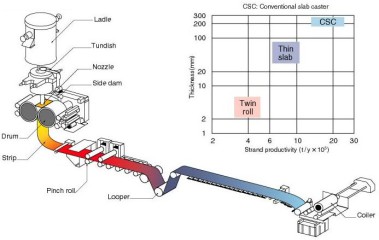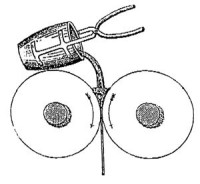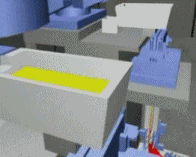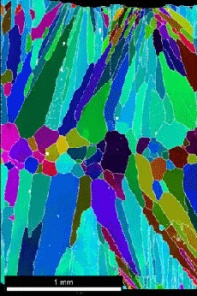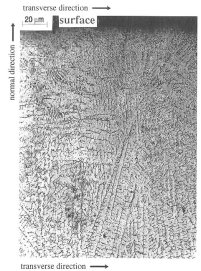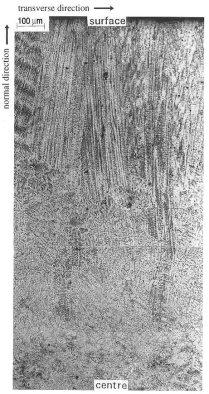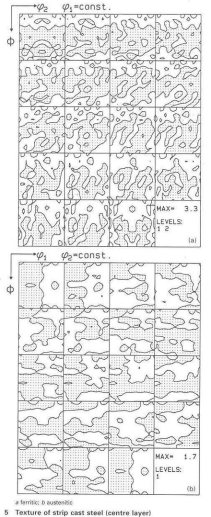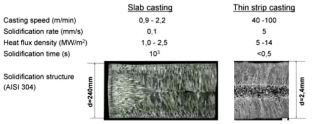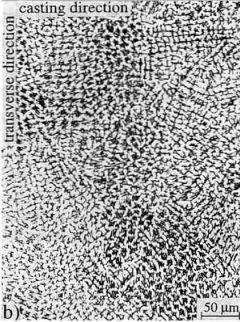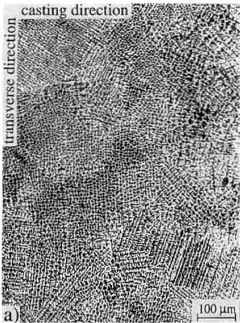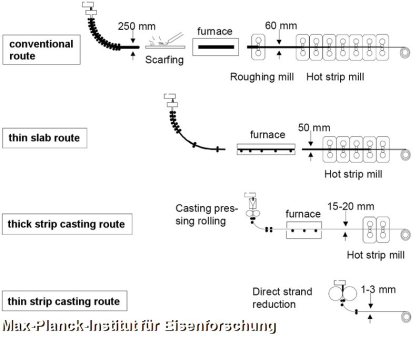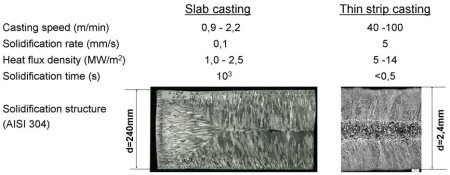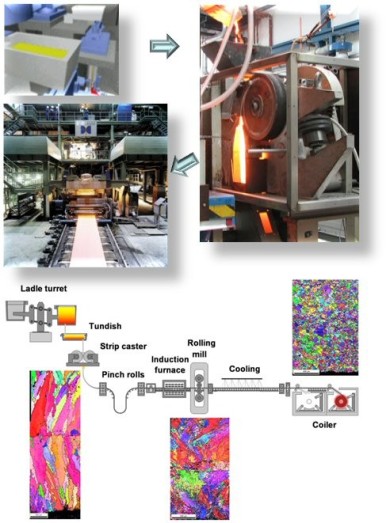Strip casting of steel
Steel sheets are conventionally manufactured by continuous casting, hot rolling, cold rolling and annealing. However, recent progress in producing steel sheets in pilot-scale twin roll strip casters has stimulated efforts to convert such devices to full commercial production.
The following sections and papers provide insights into this interesting processing alternative specifically regarding microstructure, texture, ridging and properties.
What are the advantages associated with the strip casting of steels?
Strip casting provides some basic metallurgical and commercial improvements compared to conventional steel sheet processing methods
- First, it supplies a band with the same geometry as produced by hot rolling. This permits to bypass hot rolling.
- Second, the usually weak primary crystallographic texture of the cast strip reduces anisotropy.
- Third, the high solidification rate leads to refined microstructures when compared to ordinary casting.
- Fourth, it is possible to directly cast steel sheets which are not endowed with a sufficient intrinsic ductility for rolling, such as transformer steels with a high Si content, certain intermetallic alloys or high-C steels.
- Fifth, it is not economical to produce small quantities of high grade steels by continuous casting and hot rolling. Also, capital expenditure for conventionally synthesizing hot rolled coils is much lower than for conventional casting and rolling plants. Second, the total energy required to make final products is significantly reduced and energy costs decrease accordingly. Hence, strip casting technology allows smaller steel production plants to produce products directly without the need to outsource this final stage to other companies, and thus has a strategic advantage over conventional casting technologies.
When was twin-roll strip casting of steel invented?
It was the year 1857 when inventor Sir Henry Bessemer patented the fundamentals of twin-roll casting of metals. But the full range and potential of this new idea, today referred to as strip casting, and its impact on the steel making would not be realized for generations.
Strip casting of ferritic and of austenitic stainless steels
Recent progress in strip casting technology allows the production of ferritic and austenitic stainless steels with the some geometry and quality as those produced by conventional hot rolling. This enables the entire hot rolling procedure to be bypassed_ The random initial crystallographic orientation distribution through the thickness r the cast strip leads to more homogeneous properties of the final steel sheet. The latter effect eliminates the well known ridging phenonenon in ferritic stainless steel which often deteriorates the surface quality of initially hot rolled bands. This present paper the crystallographic texture and microstructure of strip cast ferritic and austenitic stainless steel for various through-thickness depths. The results are compared with those of conventionally produced, i.e. cominuously cast and subsequently hot rolled specimens.
Materials Science and Technology May 95 Vol. 11 page 461
Raabe Mater Sc Technology 1995 vol11 pag[...]
PDF-Dokument [1.7 MB]
Thin Strip Casting of Austenitic 304 Stainless Steels
This study is about the latest advances in the optimization of the microstructure and properties of thin strip cast austenitic stainless steel (AISI 304, 1.4301). Concerning the processing steps the relevance of different thin strip casting parameters, in-line forming operations, and heat treatments for optimizing microstructure and properties have been studied. The microstructures obtained from the different processing strategies were analysed with respect to phase and grain structures including the grain boundary character distributions via EBSD microtexture measurements, the evolution of deformation-induced martensite, the relationship between delta ferrite and martensite formation in austenite, and the texture evolution during in-line deformation. It is observed that different process
steel research int. 79 (2008) 440 strip [...]
PDF-Dokument [788.8 KB]
D. Raabe, Texture and microstructure evolution during cold rolling of a strip cast and of a hot rolled austenitic stainless steel. Acta Materialia 45 (1997) 1137-1151.
Acta mater. Vol. 45, (1997) pp 1137-115[...]
PDF-Dokument [3.7 MB]
Stainless steel sheets are industrially manufactured by continuous casting, hot rolling, cold rolling and recrystallization. However, recent progress in producing
steel sheets in pilot-scale strip casters has increasingly stimulated efforts to convert such devices to commercial production [1-6]. Unequal-diameter twin roll strip casters for the
production of steels combine the two operations of casting liquid metal between two rolls and imposing a slight deformation on the solidified metal films in the rolling gap
to produce coilable strips [1-4]. Strip casting provides five main improvements in comparison to conventional processing methods. First, it supplies a steel band with the same
geometry as produced by hot rolling [1,2]. This permits the hot rolling process to be bypassed. Second, the weak texture of the cast strip leads to reduced anisotropy when compared
to
hot rolled sheets [3,4, 7-10]. Third, the high solidification rate leads to a refined microstructure when compared to conventional casting [II, 12]. Fourth, it is possible to directly
cast steel sheets that tThe recrystallization textures of the present material will be investigated in a subsequent paper [25]. are not endowed with a sufficient intrinsic
ductility for rolling, such as transformer steels with a high Si content [13,14]. Fifth, it is not economical to produce small quantities of highly alloyed stainless steels
by continuous casting and hot rolling.
Whilst many initial technical problems of twin roll strip casters have been solved [1,2, 5,6, 13, 14], the microstructure and texture that develop during rolling and annealing of strip
cast austenitic steels have not yet been studied. From previous investigations on conventionally manufactured ferritic [10,15-18] and austenitic [9,10,19-24] stainless steels it
is known that the initial grain morphology and texture can substantially influence the texture evolution during cold rolling and annealing]: Besides the description of the texture
and microstructure that result from strip casting and subsequent processing, a second more fundamental
point is of relevance as well. Unstable austenitic stainless steels undergo a strain induced phase transformation during cold rolling. This mechanism is strickly crystallographic and
thus advocates the use of quantitative texture analysis. Unstable austenitic steels can thus be regarded as a model substance for studying the deformation behaviour of an
f.c.c.-b.c.c. dual phase alloy.
Texture studies are more complicated on unstable austenitic steels than on stable ones. First, the unstable steels undergo partial strain induced phase
transformation from austenite to martensite during cold rolling. Second, the transformed volume fraction of martensite depends on the deformation path. This fact represents an
essential dissimilarity between the present material and 60/40 brass which is often used as a dual phase model substance [26,27]. Third, in unstable austenites the f.c.c. and b.c.c.
phases are not only coupled through stress equilibrium and strain compatibility but additionally through strict crystallographic transformation rules. Fourth, due to
the nearly identical chemical composition of both phases, the {III} Bragg angle of the austenite overlaps the {IIO} Bragg angle of the martensite. This paper addresses the
microstructure and crystallographic texture of a strip case and subsequently
cold rolled steel with 18 mass% Cr and 8.5 mass% Ni, in relation to the aforementioned points. The results are compared to those of conventionally produced samples. For this
purpose identical experiments were carried out using both strip cast and hot rolled starting specimens. The microstructure and texture were studied in various through-thickness
layers. The experimentally observed
cold rolling textures of the austenite were compared to Taylor simulations considering grain interaction [28]. This approach was already successfully
used for describing rolling textures of aluminium [29,30]. In the present simulations both <110) and net (211) slip vectors are considered (card glide
mechanism) [31, 32]. The texture of the martensite was simulated using a Sachs type deformation model considering {11O} (Ill) and {211}(lll) slip systems.
More specific the microstructure and texture evolution of a strip cast and of a hot rolled austenitic stainless steel (18% Cr, 8.5% Ni) during cold rolling was here studied (maximum thickness reduction Dd/d; = 80%). The microstructure of the hot band was homogeneous through the sheet thickness, except that in the centre layer a small volume fraction of martensite appeared. The hot band texture revealed a through-thickness gradient which was discussed in terms of the shear distribution during hot rolling. The microstructure of the cast strip showed globular grains with martensite in the centre layer and blocks of austenitic dendrites in the other layers. The formation of martensite was attributed to the deformation of the solidified films in the rolling gap. The strip cast sample revealed a weak texture fibre close to {OOI}(uvw) which was interpreted in terms of growth selection during solidification. During cold rolling in both types of samples the volume fraction of martensite increased up to ~ 50 vol.% (80% reduction). The cold rolling texture of the austenite was in both cases characterized by {OIl }(211) and {OIl }(100). The cold rolling texture of the hot band was stronger than that of the strip cast sample which was attributed to
the influence of the starting texture and of the grain size. The cold rolling texture of the austenite was simulated by means of a Taylor type model considering grain interaction and the so-called card glide mechanism. The martensite texture was characterized by {211}(0 II) and {II I}011). The former component was interpreted in terms of the relaxation of shear constraints. The latter was attributed to selective phase transformation of {OlI}OIl) (austenite) to {332}(113) (martensite) which then rotated towards {JII}(112). The rolling textures of the martensite were simulated using a Sachs type deformation model.
Icotom_12_strip_cast-1999-small.pdf
PDF-Dokument [1.1 MB]
Strip-Cast and Hot-Rolled Austenitic Sta[...]
PDF-Dokument [2.3 MB]
The microstructure and texture of a strip-cast as well as a hot-rolled austenitic stainless steel (18 pct Cr, 8.5 pct Ni) are investigated by the use of optical metallography and quantitative X-ray texture analysis. In the hot band, a homogeneous microstructure is revealed together with a through-thickness texture gradient consisting of a weak cold rolling type of texture in the center layer and a shear texture close to the surface layers. The result is discussed in terms of the through-thickness shear profile that is generated during hot rolling. In the strip-cast material, a random orientation distribution as well as the development of martensite close to the center layer is attributed to the impingement and deformation of the films that are solidified on the surfaces of the casting rolls. The texture close to the surface is attributed to the growth selection of {001}(uvw) oriented grains.
Materials Science Forum Vols. 157-162 (1[...]
PDF-Dokument [352.1 KB]
steel res 2003 overview hot rolling text[...]
PDF-Dokument [2.6 MB]
Further reading on strip casting of steels
- D. Raabe, M. Hölscher, M. Dubke, F. Reher, K. Lücke: Materials Science Forum 157-162 (1994) 1039-1044. Texture development of strip cast ferritic stainless steel
- D. Raabe, M. Hölscher, F. Reher, K. Lücke: Scripta Metall. 29 (1993) 113-116 Textures of strip cast Fe-16% Cr
- D. Raabe, M. Hölscher, M. Dubke, H. Pfeifer, H. Hanke, K. Lücke: Steel Research 4 (1993) 359-363 Texture development of strip cast ferritic stainless steels
- D. Raabe, K. Lücke: Mater. Sc. Techn. 9 (1993) 302-312 Textures of ferritic stainless steels
- D. Raabe: Metal. Mater. Trans. A 26A April (1995) 991-998 Microstructure and crystallographic texture of strip cast and hot rolled austenitic stainless steel
- D. Raabe: Acta Mater. 45 (1997) 1137-1151 Texture and microstructure evolution during cold rolling of a strip cast and of a hot rolled austenitic stainless steel
- D. Raabe, R. Degenhardt, R. Sellger, W. Klos, M. Sachtleber, L. Ernenputsch: Steel Res. Int. 79 (2008) 440-444 Advances in the optimization of thin strip cast austenitic 304 stainless steel microstructures
